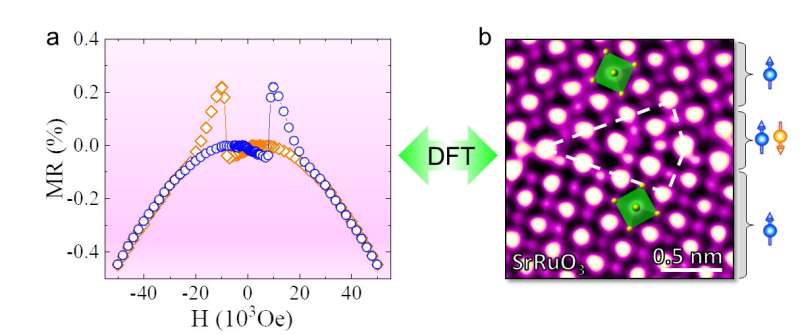A new strategy to create 2-D magnetic order

Grain boundaries, which consist of periodic arrangement of structural units and are generally recognized as a two-dimensional "phase," can exhibit novel properties that do not exist in the intrinsic bulk crystal. The altered continuity of atomic bonding at grain boundaries causes the local chemical environment to dramatically change at a few unit cells, subsequently alter local electrical activity, magnetic order or other physical properties. The effects of grain boundary on properties is even more significant in complex oxides due to the substantial interactions between lattices and other order parameters. Therefore, such an inhomogeneity of materials with grain boundaries may dominate the entire response in nanoscale devices and has garnered particular interest in designing novel functional devices.
The nature of structural defects is determined by atomic arrangements. Correlating the properties of a single defect-based device with its specific atomic structure is vital and a prerequisite for the device application. However, experimentally revealing such a structure-property relation is very challenging due to the atomic-size and chemical and structural complexity of defects, especially for the perovskite oxides that contain multiple elements.
In a new research article published in the Beijing-based National Science Review, scientists at Peking university, Institute of Physics, Chinese Academy of Sciences, and Tianjin University present an atomic mechanism of spin-valve magnetoresistance at the asymmetry SrRuO3 grain boundary. The asymmetrical atomic structure is very different from the common assumption based on prototype perovskite SrTiO3. The transport measurements exhibit the spin-valve magnetoresistance for the as fabricated centimeter-size and sub-nm-width Σ5(310) SrRuO3 grain boundary. Advanced scanning transmission electron microscopy and spectroscopy reveal its atomic arrangements based on which the first principles calculations reveal its electronic properties.
Scientists find that owing to the Ru-O octahedron distortion near the asymmetric grain boundary, Ru d orbital reconstructs and results in reduction of magnetic moments and change of spin polarization along the grain boundary, forming a magnetic/nonmagnetic/magnetic junction. The calculations bridge the atomic structure with transport properties.
"Our findings can help us to understand the past transport properties such as the negative magnetoresistance and absence of tunneling magnetoresistance at the SrRuO3 grain boundary, and also predict new effects of the SrRuO3 grain boundary such as the interfacial magnetoelectric coupling when SrRuO3 is used as a bottom electrode for growth of ferroelectric thin films." Prof. Peng Gao said, "In a broader perspective, control of defect structure at the atomic scale can realize peculiar physical properties, providing us a new strategy to design devices with new low-dimensional magnetic properties by using boundary engineering."
More information: Xujing Li et al, Atomic origin of spin-valve magnetoresistance at the SrRuO3 grain boundary, National Science Review (2020). DOI: 10.1093/nsr/nwaa004
Provided by Science China Press




















